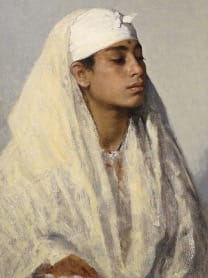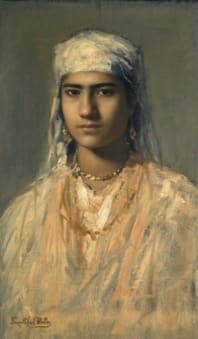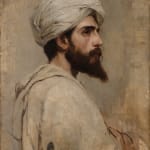Leopold Carl Müller (1834 - 1892)
Further images
Portrait of a man wearing a burnous and turban
Oil on canvas, unlined
68.8 x 50.5 cm. (27 x 19 ¾ in.)
Portrait of a man wearing a burnous and turban
Oil on canvas, unlined
68.8 x 50.5 cm. (27 x 19 ¾ in.)
We are grateful to Charles Greig for confirming the attribution to Müller, after first-hand inspection.
This striking portrait study can be dated confidently to 1882, the year of one of Leopold Carl Müller’s visits to England, or very shortly thereafter, thanks to the Brodie & Middleton stamp on the reverse of the canvas, whose typeface corresponds to canvasses produced by the Covent Garden-based firm between 1880 and 83.[1]
Müller was greatly acclaimed in Britain, often sending works for exhibition there following the advice Edward Prince of Wales and the art dealer Henry Wallis, both of whom he had met in Cairo. Wallis was responsible for the sale of a large number of Müller’s paintings to English collectors, leading the artist to first visit London in 1875, and then several times thereafter. Müller therefore likely executed this painting on his 1882 visit, and indeed to judge from his features, the sitter appears to be Northern European. Yet he wears a burnous, a long hooded cloak of coarse woollen fabric traditionally worn by Berbers, and a turban. The sitter is possibly therefore a European who had some sort of link to North Africa through study or travel. However, if painted in England, more likely perhaps is that the sitter has been dressed by Müller and that the picture is therefore more of an artistic exercise, which would reconcile the unfinished nature of the painting, along with the lack of signature (uncommon but not unknown in Müller’s oeuvre). Of course, it is not impossible that the picture was painted in Egypt, with Müller taking the canvas with his artistic supplies. Alexandria, the gateway to the Nile, was a melting-pot of peoples from all over the Mediterranean, including many from the Balkans, much of which was still nominally under Ottoman control around 1880, like Egypt itself.

Fig. 1, Leopold Carl Müller, A modern day Sphinx, oil
on canvas, 66.5 x 40 cm, Belvedere Museum, Vienna
Müller was born in Dresden to Austrian parents, beginning his artistic training under Karl von Blaas. A government stipend enabled
the young painter to visit the Exposition Universelle of 1867 in Paris, where he was greatly impacted by the paintings of Eugène Fromentin. In the winter of 1873 Müller embarked on the first of nine extended tours of Egypt, immersing himself deeply in the local culture, and painting both scenes of everyday life and individual portraits. In 1877 Müller took a professorial post at the Vienna Academy, teaching many prominent Orientalist artists of the next generation, including Ludwig Deutsch, Paul Joanowitch and Charles Wilda. Müller was from an incredibly gifted artistic family: two sisters, Marie and Berta, were accomplished and well-known portrait painters, and a third sister Josephine married the painter Eduard Swoboda. Their children Josephine and Rudolf were both gifted artists, with Rudolf studying under his uncle Müller and accompanying him to Egypt in 1879, before travelling to India in 1886 under the patronage of Queen Victoria.

Fig. 2, Leopold Carl Müller, An Egyptian
girl, oil on canvas, 47 x 28 cm, Private Collection
[1] See the National Portrait Gallery’s online resource listing London-based artistic suppliers between 1830 and 1930: https://www.npg.org.uk/assets/files/pdf/research/D.marks2_A_D.pdf





